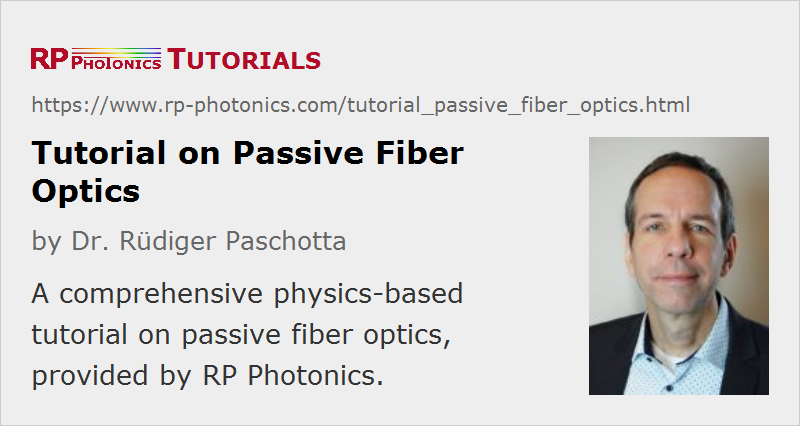Tutorial: Passive Fiber Optics
This is part 8 of a tutorial on passive fiber optics from Dr. Paschotta. The tutorial has the following parts:
2: Fiber modes
3: Single-mode fibers
4: Multimode fibers
5: Fiber ends
6: Fiber joints
7: Propagation losses
8: Fiber couplers and splitters
9: Polarization issues
10: Chromatic dispersion of fibers
11: Nonlinearities of fibers
12: Ultrashort pulses and signals in fibers
13: Accessories and tools
Part 8: Fiber Couplers and Splitters

When using fiber optics, one often needs to use fiber couplers for various purposes. Some examples:
- A coupler can be used as a splitter to couple out some portion of the light circulating in the resonator of fiber laser, for example. Directional 2 × 2 couplers (see Figure 1) are usually used for such purposes.
- The same kind of devices is useful in fiber interferometers, also for combining two inputs. (Note that polarization issues might occur.)
- Dichroic couplers can be used to combine a pump and a signal input for a fiber amplifier, or to remove residual pump light after the amplifier.
- For high-power fiber lasers and amplifiers, one often needs pump couplers with multiple inputs, combining the outputs of several high-power diode bars.
The probably most often used operation principle of a directional fiber coupler is evanescent wave coupling in a configuration where two fiber cores come close to each other. Such a device can be made by heating two bare fibers such that the glass begins to melt and the fibers fuse together. One might also slightly pull the fibers during that process. A refractive index profile obtained in that way is shown in Figure 1:

Both waveguides are single-mode waveguides with a super-Gaussian index profile. The coupling region in the middle is only a few millimeters long. Outside that region, the coupling is negligible, as the mode fields really don't touch each other.
With numerical beam propagation, one can now check what happens when light is injected only into the upper left input port:

In this particular situation, the light first couples almost entirely to the lower waveguide after a short distance, but then back to the upper waveguide, and finally most of the power remains there. As the coupling strength depends sensitively on the wavelength, for some other wavelengths one may e.g. get nearly all power to cross over to the lower output port. The simulated wavelength dependence is shown in Figure 4. The somewhat strange shape of the curve in the longer-wavelength region results from bend losses of the waveguides, which get substantial in that region.

If the coupling is made weak (through the waveguide distance) but can occur over a longer length, the wavelength sensitivity gets stronger. Conversely, broadband couplers require a strong coupling over a short length.
Note that such couplers are directional couplers: essentially no light couples into the “backward” direction.
Of course, one can inject light into both input ports of such a fiber coupled. The outputs will then be a linear superposition of electric field amplitudes caused by the two inputs, assuming that the optical intensities are not high enough to cause nonlinear effects. Particularly for fiber couplers made from single-mode fibers, one can obtain destructive interference in one of the output ports if two coherent inputs of correctly chosen powers, polarization directions and relative phases are injected. In such a case, constructive interference will occur for the other output port; the overall power has to be preserved, of course, apart from some possible parasitic power losses.
Pump couplers for high-power fiber lasers and amplifiers are different in some respects. The input and output fibers are strongly multimode, with large cores and high numerical aperture. The coupling principles can also be different from that in the example case above. For example, instead of evanescent wave coupling one may simply inject light from smaller cores into a large core for the output. Power losses must be carefully minimized – partly because lost light at high power levels might destroy the coupler.
Go to Part 9: Polarization Issues or back to the start page.
Questions and Comments from Users
Here you can submit questions and comments. As far as they get accepted by the author, they will appear above this paragraph together with the author’s answer. The author will decide on acceptance based on certain criteria. Essentially, the issue must be of sufficiently broad interest.
Please do not enter personal data here; we would otherwise delete it soon. (See also our privacy declaration.) If you wish to receive personal feedback or consultancy from the author, please contact him, e.g. via e-mail.
By submitting the information, you give your consent to the potential publication of your inputs on our website according to our rules. (If you later retract your consent, we will delete those inputs.) As your inputs are first reviewed by the author, they may be published with some delay.





2020-11-30
What about the problem of energy conservation in the case of a coupler with two inputs and only one output?
The author's answer:
If the involved fibers are all single-mode, part of the optical power must be lost in the device, unless perhaps in certain cases with mutually coherent inputs. A full discussion of that topic would go far beyond the topic of this tutorial.